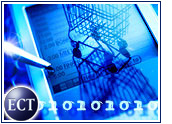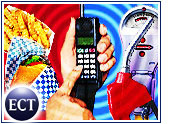
Back in early 2000, mobile commerce seemed to have sky-high potential. A global surveyfound that 61 percent of respondents imagined they soon would be using wireless devicesas universal payment tools, and the analysts who compiled the survey predicted that overall revenue generated by m-commerce would total US$100 billion in 2003.
“The hype came in a big way, and then it died in an even bigger way, because the hypewas never really justified to begin with,” Yankee Group analyst Adam Zawel told theE-Commerce Times. “But m-commerce is not dead on the vine; it’s just a much longergrowing season than we expected.”
Shallow Grave?
Although some may think m-commerce is a spectacular failure, others in the industrybelieve it is a sleeping giant whose time has yet to come. “It’s still too early to tell whether it will be successful or not because it hasn’t really existed yet,” said Verizon Communications’ Jeffrey Nelson, executive director for corporate communications. “For Verizon Wireless, it’s too early to begin implementing an m-commerce strategy. It’s something that we’re thinking about, but it’s years down the road.”
Nelson told the E-Commerce Times that, over time, there have been many different ideas about the definition of m-commerce. At one time, it was seen as consumers using a wireless device to buy soda from a vending machine or order books from Amazon.com. At another, it was defined as a mobile phone spitting out a coupon for 10 cents off a latt as a consumer strolled past a Starbucks.
Although mobile commerce has many facets, including the ability to conduct wireless banking, access the Internet or find information on the fly, most consumers now think of it as a wireless wallet — the ability to make financial transactions at a point of sale using a wireless device. In this scenario, consumers are recognized by the signals they emit, most likely from their wireless phones or PDAs, and they can purchase goods and services from vending machines and businesses without having to use a checkbook, credit card or cash.
But making the wireless wallet a reality will require an evolution of both technologyand consumer attitudes that is still far in the distance. “I spend all my time on m-commerce, but I can’t pick a point when all of these pieces are going to come together, when it’s all going to work as perfectly as we’d like,” Zawel said. “But while I can’t pinpoint the date, I am convinced that we will continue to see a move in that direction because the idea is so compelling.”
A Resurrection?
Zawel explained that a three-phase process will be required to fully implement a wireless wallet: a communication phase, a content phase and a commerce phase. He said we are just beginning to move beyond the communication phase: More than 50 percent of the U.S. population now uses a wireless phone for voice or text messaging communication.
The phase we are entering, the content phase, is one in which people purchase content that is then delivered to their wireless device. Such content may include graphics, games, information such as sports scores, and ringtones. “We’re predicting people in the U.S. will spend $50 million just buying ringtones this year,” Zawel said.
But he noted that m-commerce content providers are facing the same struggle as everyother Internet content provider. “As consumers, we’ve been trained to expect a lot of stuff for free online,” Zawel said, “and content providers are struggling to charge for content, whether it’s a newspaper Web site or a sports Web site. Will they start out with a few years of free content on wireless, or has their patience been worn thin by their Internet experiences?”
The Commerce Challenge
Zawel said he sees the final phase as the commerce phase, in which consumers are usingwireless devices to purchase real goods in the physical world that are not necessarily delivered to their wireless device. Once we enter this phase, consumers will begin to accept m-commerce fully. But Zawel said that early in the commerce phase, it will be a challenge to convince consumers to leave their credit cards at home and let their phones do the purchasing.
“The industry will have to include some incentive for the end user,” he noted. “If we’re talking about using a device at the point of sale, it’s going to have to be quicker and cheaper than pulling out cash or a credit card.”
To make the wireless wallet a reality, Zawel said, companies are actively investing in them-commerce of tomorrow, from the smallest player serving as an intermediary between billing vendors and content providers, to the largest mobile carriers like Verizon and AT&T, which see m-commerce as one of their top five initiatives.
What Will It Take?
Mike McCamon, executive director of the Bluetooth Special Interest Group, told the E-Commerce Times that several factors must be in place to make m-commerce and the electronic wallet a reality. First, consumers will need easy-to-carry wireless devices that they will always have with them, and terminals will have to be available at stores or in vending machines. Both of these devices must have the necessary infrastructure to enable transactions.
Second, there must be a high density of both consumer devices and terminals, and they must be pervasive. “It has to save time, it has to be convenient, and it has to work everywhere,” McCamon said.
Last, and most difficult, there must be a worldwide standards initiative. McCamon recalled that when he lived in Europe, not all of his credit cards from the United States worked there; conversely, his Bank Suisse credit card did not work in the United States. “That’s an industry that’s been around for nearly 40 years, and we still don’t have universal standards,” he said.
Nevertheless, McCamon said the Bluetooth Special Interest Group is bullish about the future of m-commerce and about devices that think and interact with their environments without user intervention. “I’m optimistic, but also very realistic that this will take time — a lot of time.”
Why Not Now?
As m-commerce technology becomes available in the future, McCamon said, consumers will say: “‘My credit card works pretty well, and I never have to charge it. So what’s my value-add for me as a consumer?’ All too frequently in the technology industry, we take the ‘Field of Dreams’ approach, believing that if we build it, they will come. Too often we don’t ask ourselves what the problem is that we’re really trying to solve.”
He added that m-commerce defied earlier predictions not because consumers or vendors did not like the idea or the technology behind it; rather, he said those in the industry simply did not do a good job of explaining how m-commerce could improve everyone’s lives.
“I think this is true of all technology products, not just short-range financial transactions,” he noted. “Twenty years ago, we had to explain to people why laser printers were better. To make m-commerce work, we’ll have to explain what the value is for them, and I think we still have some work to do on that.”



















































It is absolutely NOT dead, but just now being born. Your cell # will soon be your credit card #, and the camera in your phone is now a barcode scanner and text translator. All catalogs and advertisements will soon have barcodes included!
My company is developing these solutions!
email me if you want to know more..
Here in Europe M-Commerce is sloqing rolling out. Vodafone has a product called M-Pay that lets users buy Tickets and other items and have them billed to either a credit card or the phone bill.
Friends in Finland do not carry change for parking anymore; they just text the machine and it is credited to their phone bill. Even in Germany the networks have schemes, this is a country that likes to pay cash!
Just as you were slow to see the value in SMS this is something that will follow once you start living in the Thumb Tribe! It will take you longer in the US as you don’t have a single standard, the other issue is that because of size you cannot give blanket coverage. But the SIM card in your phone is more secure than the plastic in your pocket and so it is just a question of time before you take the technology, repackage it and then sell it back to us.
Dear Mr. Ward,
Thank you for taking the pulse of the wireless wallet industry. As the CEO of one of the key companies in this field, I, as expected, see the cup as half full. I believe as such, since ViVOtech is rolling out the exact wireless wallet solution as you mention (customer walks up to point of sale, points a PDA/mobile telephone, and, bingo, the cash register responds and approves the sale) in five major cities in the United States with approximately 50,000 users now and two other countries in the near future. Whereas ViVOtech’s initial success has not bubbled up to the likes of your stories but soon it will become apparent that the challenges you so eloquently delineate have been conquered step-by-step.
All the best.
Jorge Fernandes